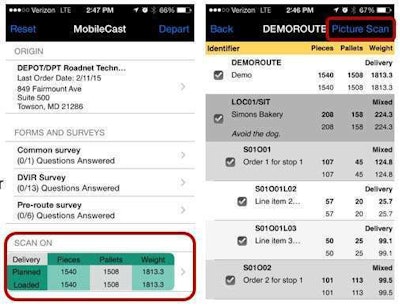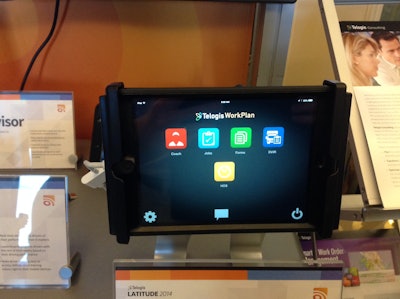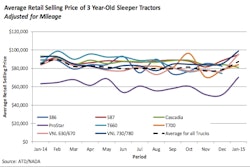During the first week in March, icy rain and snow blanketed much of Southeastern Foods Merchandisers’ network, forcing the distributor to postpone deliveries of food-service products to some customers.

The software factored in historical order volumes for the week to show managers how the rest of the week would pan out, says Jason Chestnut, director of operations for the Pelham, Ala.-based company. Chestnut also modeled various “what if” scenarios to thwart surprises like drivers having to reset their hours if some deliveries were pushed out to Sunday, Mar. 8.
“I couldn’t imagine doing it without Paragon,” he says.
 Paragon Systems recently acquired Axida to offer routing software to fleets with home delivery service.
Paragon Systems recently acquired Axida to offer routing software to fleets with home delivery service.Commercial or private fleets with fixed routes like Southeastern Foods typically schedule multiple pickups and deliveries per truck each day, as do fleets with more dynamic routes with less-than-truckload and parcel-size shipments.
Besides helping fleets to cut costs and keep customer service commitments, routing software has become a hot commodity for technology companies looking to expand their reach into all segments of the transportation industry.
Three-way integration
Southeastern Foods has been using the Paragon RMS software from Paragon Systems for about six years. Transportation managers use it daily to fine-tune fixed routes for 20 trucks, and to periodically redesign its overall network. Recently, about two-thirds of all routes were re-designed to achieve a cost savings of 15 percent through a reduction in fuel, mileage and labor.
Chestnut says the software helps with testing various strategic “what if” scenarios like what the impact would be of using more straight trucks rather than semi-trailers in the fleet. Going forward, the company will be using smaller trucks and operating multiple shifts. “We absolutely learned that by having Paragon,” he says.
 MobileCast from Roadnet Technologies puts optimized routes and workflow in the hands of drivers
MobileCast from Roadnet Technologies puts optimized routes and workflow in the hands of driversSoutheastern developed its own order management system, which interfaces with Paragon RMS to send daily order files that contain delivery details. Once Paragon builds a route plan for the orders, transportation managers review and save routes for that day. The route data is then automatically sent to drivers through the company’s mobile computing platform to execute in sequence.
Southeastern Foods also uses Paragon to compare the route plan with actual performance. Position data captured from its mobile system comes back to Paragon for post-mortem analysis. Managers can also see within Paragon how routes are progressing at any time during the day, he says.
Built-in routing
In some cases, the routing of orders can take place directly in the transportation management system, rather than through an interface with a third party application. Carrier Logistics (CLI) offers the FACTS transportation management system (TMS) for carriers with multi-stop operations. A built-in feature, Routronics, matches orders to routes and sequences the stops to reduce mileage.
The FACTS system integrates with various third-party mobile apps to provide route instructions to drivers, and to update tracking information. FACTS also provides real time route monitoring and post-mortem reporting.
Omnitracs is one of several technology suppliers in the transportation industry that have acquired routing software companies in the past few years. In December, 2013, it purchased Roadnet Technologies, which provides fleet management software to private fleets. Less than a year later, Omnitracs also purchased XRS Corp., to broaden its reach to fleets seeking out-of-the cab, smart device-based applications.
Roadnet already had an app that runs on handhelds, including smartphones and tablets, called MobileCast. The app presents the route and delivery sequence to drivers along with details about the order and customer at each stop. Scanning capability ensures drivers are picking up and delivering the right products, and it has an automated proof-of-delivery feature with electronic signature capture.
 Telogis offers all of its telematics, routing and mobile applications through a software-as-a service platform.
Telogis offers all of its telematics, routing and mobile applications through a software-as-a service platform.Fleets can turn on additional capabilities and workflows like mobile printing and custom forms to “collect any data you want,” says Kevin Haugh, vice president and general manager of Omnitracs’ Roadnet division.
The one thing MobileCast does not do is capture drivers’ hours of service and engine telematics data, but this information can be imported in Roadnet to have a single reporting platform. Roadnet developed a telematics framework to bring information in from Omnitracs, XRS and from third-party telematics providers, he says.
Trimble also has acquired a full suite of transportation technology through its TMW Systems and PeopleNet subsidiaries. Telogis developed its own integrated software as a service platform that gives end users the freedom to use any device, including smartphones and tablets, to run its commercial navigation, compliance, telematics, route optimization, work order management and mobile integration services.
To make the most of routing software, it seems, takes a combination of technologies on the front and back end. Increasingly, this combo package – with the TMS, the routing software, and the mobility applications – is being offered by the largest technology providers in the transportation industry.





![shutterstock_118521220[1]](https://img.ccjdigital.com/files/base/randallreilly/all/image/2015/03/ccj.shutterstock_1185212201.png?auto=format%2Ccompress&fit=crop&h=167&q=70&w=250)






